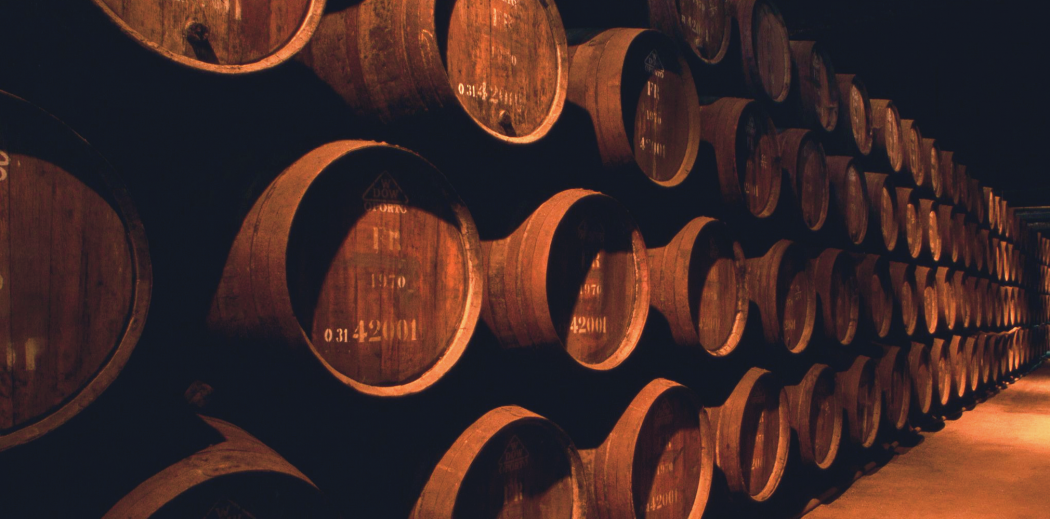Port wine is one of those enigmatic booze that’s up there with brandy, absinthe, and scotch. What the heck is it and what makes it distinct?
Port wine is a fortified wine that comes exclusively from the Douro Valley region of Portugal. You probably know it as a sweet after dinner drink, but many Portuguese consider it their lifeblood, and it’s been a major export for the country for a few hundred of years.
Yes, it is sweet, but that’s just the start of this complex digestif. Its production is complicated and – if you’re lucky enough to find the right producer – traditional, and the longer it ages the better it gets.
The Douro Valley is a region in northern Portugal that’s been producing red wines for thousands of years. The winemakers here started making port in the 1600s in response to trade with the English, whose tastes weren’t favorable to the tart reds that were commonly exported from Portugal at the time. Port was rich, robust alternative. Made from the darker red grapes found further down the Douro, these wines were thought to be more appealing as exports, and the Portuguese capitalized. Production increased, and producers began to ship boats filled with wine barrels upriver toward the city of Porto, where they would be transported overseas. To allow the barreled wine to survive the journey without spoiling, the producers in the Douro Valley started to fortify the wine with a highly alcoholic brandy, called aguardiente, as a preservative. This fortification was the start of the port we know today.
How It’s Made
At some wineries (especially those with small production numbers, like Quinta da Pacheca in Peso da Régua), the red wine grapes are collected and put into vats, where teams of men stomp the skins and juice apart at harvest time. This method allows the seeds to be sorted out, taking out the bitterness from that part of the grape. Other port wineries, especially the larger producers, use a mechanical method to separate the skins, which allows for quicker, less precise production, but means they can make more wine in the end. White wine varietals can also be made into port, following a similar method, except those grapes are typically machine crushed, rather than done by foot.
Once the grapes are crushed, the wine is filtered out of the vat and start their fermentation process as red wine. Meanwhile, the stomped skins and mash left in the vat is collected and used to create aguardiente. The mash is fermented and distilled to create the potent wine—we’re talking 70 proof. This strong brandy is added to the red wine after three or four days of fermentation and stops the fermentation in its tracks, due to the high alcohol content in the brandy. The result is a sweeter wine that hasn’t gone through full fermentation but still contains some of the fruit’s sweetness—and, a very strong wine, thanks to the highly alcoholic brandy.
Aging
It’s the aging process that really brings out the life of a port. Some are aged only for about three years, while other producers don’t even bottle their port until it’s aged at least seven years. The best ports, though, are those that have been aging for 10, 20, 30 years, and beyond. As these ports age, a tiny bit of the liquid inside the barrel is absorbed by the wood and evaporates out. This is called the angel’s share. Because of this natural process, port makers add more wine to the barrels to keep the levels the same continuously. They also often add flavor enhancers to the barrels as well. For white ports, nuts like peanuts and pistachios are added, and dark red fruits are added to red port wine barrels. The process of aging makes the port wine more complex, as the wine collects the flavor from the barrel, the wine and other ingredients that are added during the process. That’s why, as a white port ages, it grows darker in color. A 10-year-aged white port won’t be white, but it will be a clear amber, since it’s collected some of the caramels and nutty flavors from the barrel it rests in. Red ports, on the other hand, will become lighter with time. Going into the barrels as a deep red, and deepening in color with the addition of fruits, the color fades as the slow fermentation continues in the barrel and the port wine assumes some of the flavors of its environment.
Touriga nacional is the most popular grape varietal used for port wines. It grows the best in these difficult conditions and makes some of the finest ports sold today. Never heard of it? It’s a grape distinct to Portugal, and it’s a small, potent fruit, so its flavors are robust, but it produces a low yield. Many compare it to a cabernet sauvignon or cabernet franc.
So, Now What?
So, you want to buy some port for Thanksgiving or your sister’s wedding, but you don’t know where to start. There are a few different types of port. There are Tawny port wines, which the Portuguese just call red port. This type of port is filtered and ages only in the barrel, which gives it its caramel color. Once it’s bottled, it stops aging, and you can open today and still drink it three years from now—that is, if you have some incredible willpower! Then, there are Vintage port wines. These wines are unfiltered and, though they’re aged in barrels as well, they continue to age when they’re bottled. They tend to be a very dark red and a touch more sweet than tawny, and these port wines come from the best crop from the best growing years—a designation that is officially decided by the Douro and Port Wine Institute. Late Vintage Port (on the label as LBV) is very similar to Vintage, except the grapes aren’t declared vintage. That means that these bad boys are almost half the price of their vintage cousins, but without losing much quality. Then there are white ports, which get darker and more complex with age. Ruby port wine, the most commonly sold, are the youngest and fastest to produce, and they’re stored in stainless steel tanks as opposed to barrels, and they don’t age in the bottle. Bottom line, avoid ruby if you can help it.
There are a few other variations, but understanding the aging and naming process is half the battle when it comes to deciding on a good port. After you understand that, it’s up to you and your palate.
Serving Port
Most ports are better when served slightly chilled. A good rule of thumb is to stick it into the fridge for 15 to 20 minutes before serving. The purpose of this is to mask some of the initial alcohol flavor to really allow the fruit flavors to come forward when you first sip. Otherwise, some of the best ports can seem a bit too strong.
When to Drink It
There are arguments as to when the best time to enjoy port is. The French and Northern Europeans tend to enjoy it as a before-dinner aperitif. The English and Americans prefer port as a digestif, paired with desserts and chocolate after a big meal. The Portuguese, however, have a different take on the beverage. They enjoy it whenever they damn well please.
After all, as they say in Portugal, a port a day keeps the doctor away.








